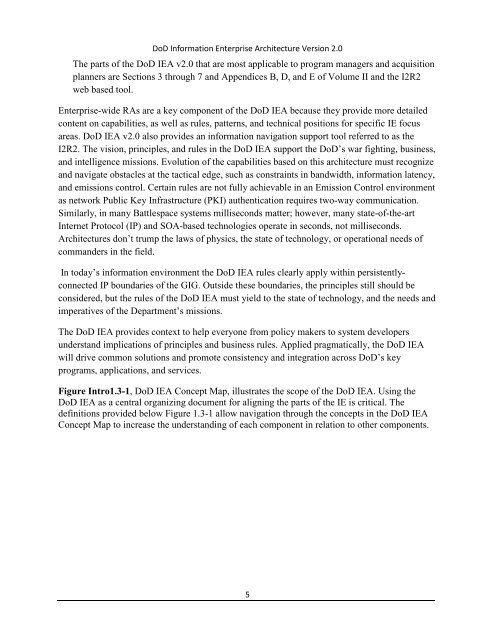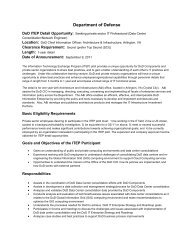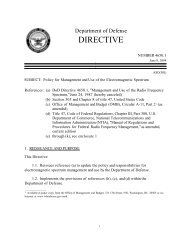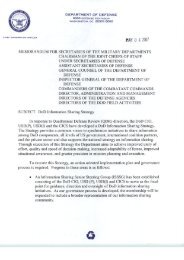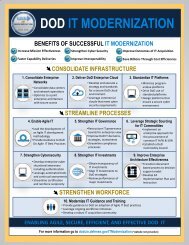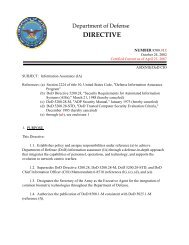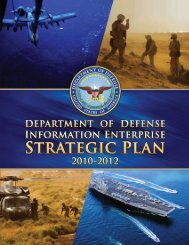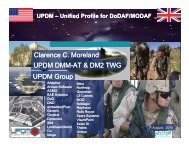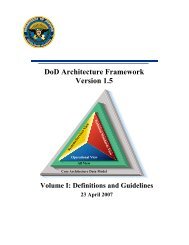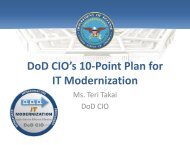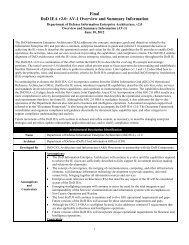DoD IEA v2.0 - Chief Information Officer
DoD IEA v2.0 - Chief Information Officer
DoD IEA v2.0 - Chief Information Officer
You also want an ePaper? Increase the reach of your titles
YUMPU automatically turns print PDFs into web optimized ePapers that Google loves.
<strong>DoD</strong> <strong>Information</strong> Enterprise Architecture Version 2.0The parts of the <strong>DoD</strong> <strong>IEA</strong> <strong>v2.0</strong> that are most applicable to program managers and acquisitionplanners are Sections 3 through 7 and Appendices B, D, and E of Volume II and the I2R2web based tool.Enterprise-wide RAs are a key component of the <strong>DoD</strong> <strong>IEA</strong> because they provide more detailedcontent on capabilities, as well as rules, patterns, and technical positions for specific IE focusareas. <strong>DoD</strong> <strong>IEA</strong> <strong>v2.0</strong> also provides an information navigation support tool referred to as theI2R2. The vision, principles, and rules in the <strong>DoD</strong> <strong>IEA</strong> support the <strong>DoD</strong>’s war fighting, business,and intelligence missions. Evolution of the capabilities based on this architecture must recognizeand navigate obstacles at the tactical edge, such as constraints in bandwidth, information latency,and emissions control. Certain rules are not fully achievable in an Emission Control environmentas network Public Key Infrastructure (PKI) authentication requires two-way communication.Similarly, in many Battlespace systems milliseconds matter; however, many state-of-the-artInternet Protocol (IP) and SOA-based technologies operate in seconds, not milliseconds.Architectures don’t trump the laws of physics, the state of technology, or operational needs ofcommanders in the field.In today’s information environment the <strong>DoD</strong> <strong>IEA</strong> rules clearly apply within persistentlyconnectedIP boundaries of the GIG. Outside these boundaries, the principles still should beconsidered, but the rules of the <strong>DoD</strong> <strong>IEA</strong> must yield to the state of technology, and the needs andimperatives of the Department’s missions.The <strong>DoD</strong> <strong>IEA</strong> provides context to help everyone from policy makers to system developersunderstand implications of principles and business rules. Applied pragmatically, the <strong>DoD</strong> <strong>IEA</strong>will drive common solutions and promote consistency and integration across <strong>DoD</strong>’s keyprograms, applications, and services.Figure Intro1.3-1, <strong>DoD</strong> <strong>IEA</strong> Concept Map, illustrates the scope of the <strong>DoD</strong> <strong>IEA</strong>. Using the<strong>DoD</strong> <strong>IEA</strong> as a central organizing document for aligning the parts of the IE is critical. Thedefinitions provided below Figure 1.3-1 allow navigation through the concepts in the <strong>DoD</strong> <strong>IEA</strong>Concept Map to increase the understanding of each component in relation to other components.5


